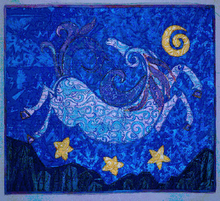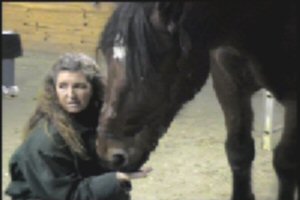Q: Hi Gwen,
I was with a friend, and she stopped at one of her aquaintances house. There was a lady there with a small trailer, and a two yr old horse. The horse was there to be trimmed, when we were there the man had already finished with her, and you could tell her feet were sore by the way she was holding them. They were trying to load her onto the trailer, and you could tell she was just terrified. She jerked back, flipped over backwards, and they kept on trying to force her in. There ended up being 3 big men trying to force this poor girl in, they had a rope under her belly, one around her neck, and one behind her butt, plus they were hitting her with the ropes, swinging very very hard. I tried to intervene, it made me sick just to see it, but they refused any help. In an instance like that, IF you can get the owners to stop and let you have a go, what is the best way to get a scared horse in so that they will stop abusing it?
A: Well, actually, Angela gave a perfect example of how to do this without physical force in a situation where time is of the essence. But, depending on the time that everyone has, it all boils down to changing the horse's beliefs. People with ropes around the horse is serving one purpose only ... Scaring the pants off the horse! Absolutely embedding the fear of trailering (and of humans) into the horse and displaying a choreographed lesson in learning one cannot win a tug of war against a 1/2 ton animal.
Part of the foundation of teaching a scared horse onto a trailer (or anywhere else) is to learn to know/feel what an animal expects to happen next ... (horse's belief)... And then be able to teach the horse to change his beliefs. Neither you nor I nor anyone else can do that for him. The horse has to change his own beliefs and has to learn to actively override his choices to believe that the one choice that he's going to make is going to put him in a better place than the moment before. In this case, the horse was terrified and being asked to go into a small, cavern-like space with 3 huge men bullying him making him believe he's going to die. So, you can see that this cannot be done in any sort of humanely contrived time limit. But, with positive reinforcement, the time involved can be reduced considerably as each moment the horse is changing his beliefs is going to speed up the process for the next change. The first belief that needs to be changed is the belief the horse is going to die. That is a panic response that is autonomic. It's hardwired into the horse - the "flight" response. This is the strongest survival instinct the horse has. To override that one needs to catch the horse just the split second BEFORE it kicks into gear. Once its in gear then the horse HAS to move its feet and it ain't gonna be moving them towards the cave that's going to engulf him! So, let the horse move its feet. Let him move away from the trailer. Stay with the horse doing nothing ... Just staying with him. Once the horse starts to settle, mark that behavior (click) and reward him (treat). You mark the "settling", or the "relaxing". From there you can now get a foot in the door. Build up, step-by-step, figuratively and actually, to where you can begin to direct the horse's feet. You start with the head-down (relaxation) then work from there but only AFTER you've gotten the horse to stop moving its feet in fear. Don't FORCE anything ... Force is only going to undo all that you've already done and set you back gazillion steps. Remember to reward the try ... And once the horse has completed a task just 3 times perfectly, move onto the next step. Don't keep on repeating over and over and over. Again, know/feel what the horse believes is going to happen "next" and change that "belief" by asking the opposite. If the horse believes that you're going to ask for another step forward, ask for a step backwards or sideways and CT. Then ask for the step forward. That way you're interrupting the "stuck" belief and causing the horse to think. As he's thinking, he's changing his beliefs. So HE'S the one making the changes; you are not the one forcing them. It's important to allow horses to believe HE'S the one making the changes - everything your horse believes he's learned from his own interpretations and experiences. All beliefs are learned but not all are 'taught'.
I know this is a very general answer but it has to be cause each horse is an individual and has individual beliefs. But the concept is universal when working with horses at any time.
Subscribe to:
Post Comments (Atom)



No comments:
Post a Comment